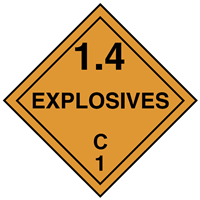
 Print
Print
Chemical Datasheet
5-MERCAPTOTETRAZOL-1-ACETIC ACID |

|
Chemical Identifiers
| CAS Number |
UN/NA Number |
DOT Hazard Label |
USCG CHRIS Code |
|
|
|
|
none
|
| NIOSH Pocket Guide |
International Chem Safety Card |
|
none
|
none
|
NFPA 704
data unavailable
General Description
A solid or liquid. May be liable to extremely rapid burning. Explosive effects largely confined to the package. No projection of fragments of appreciable size or range expected.
Hazards
Reactivity Alerts
Air & Water Reactions
No rapid reaction with air. No rapid reaction with water.
Fire Hazard
Excerpt from ERG Guide 114 [Explosives - Division 1.4 or 1.6]:
MAY EXPLODE AND THROW FRAGMENTS 800 METERS (1/2 MILE) OR MORE IF FIRE REACHES CARGO. (ERG, 2024)
Health Hazard
Excerpt from ERG Guide 114 [Explosives - Division 1.4 or 1.6]:
Fire may produce irritating, corrosive and/or toxic gases. (ERG, 2024)
Reactivity Profile
The organosulfides are incompatible with acids, diazo and azo compounds, halocarbons, isocyanates, aldehydes, alkali metals, nitrides, hydrides, and other strong reducing agents. Reactions with these materials generate heat and in many cases hydrogen gas. Many of these compounds may liberate hydrogen sulfide upon decomposition or reaction with a strong oxidizing acid. The unsubstituted tetrazole is unstable when heated above its melting point. Its solutions are also explosive when shocked. Carbonyl azides are explosive, some exceptionally so, and suitable handling is necessary, Leiber, E. et al., Chem. Rev., 1965, 65, 377.
Belongs to the Following Reactive Group(s)
- Acids, Carboxylic
- Azo, Diazo, Azido, Hydrazine, and Azide Compounds
- Ketones
Potentially Incompatible Absorbents
No information available.
Response Recommendations
Isolation and Evacuation
Excerpt from ERG Guide 114 [Explosives - Division 1.4 or 1.6]:
IMMEDIATE PRECAUTIONARY MEASURE: Isolate spill or leak area immediately for at least 100 meters (330 feet) in all directions.
LARGE SPILL: Consider initial evacuation for 250 meters (800 feet) in all directions.
FIRE: If rail car or trailer is involved in a fire, ISOLATE for 800 meters (1/2 mile) in all directions; also initiate evacuation including emergency responders for 800 meters (1/2 mile) in all directions. If fire threatens cargo area containing packages bearing the 1.4S label or packages containing material classified as 1.4S, consider isolating at least 15 meters (50 feet) in all directions. (ERG, 2024)
Firefighting
Excerpt from ERG Guide 114 [Explosives - Division 1.4 or 1.6]:
CARGO FIRE: DO NOT fight fire when fire reaches cargo! Cargo may EXPLODE! Stop all traffic and clear the area for at least 800 meters (1/2 mile) in all directions and let burn. Do not move cargo or vehicle if cargo has been exposed to heat.
TIRE OR VEHICLE FIRE: Use plenty of water - FLOOD it! If water is not available, use CO2, dry chemical or dirt. If possible, and WITHOUT RISK, use unmanned master stream devices or monitor nozzles from maximum distance to prevent fire from spreading to cargo area. Pay special attention to tire fires as re-ignition may occur. Stand by, at a safe distance, with extinguisher ready for possible re-ignition.
CLASS 1.4S FIRE: Packages bearing the 1.4S label or packages containing material classified as 1.4S are designed or packaged in such a manner that when involved in a fire, they may burn vigorously with localized detonations and projection of fragments. Effects are usually confined to immediate vicinity of packages. Fight fire with normal precautions from a reasonable distance. (ERG, 2024)
Non-Fire Response
Excerpt from ERG Guide 114 [Explosives - Division 1.4 or 1.6]:
ELIMINATE all ignition sources (no smoking, flares, sparks or flames) from immediate area. All equipment used when handling the product must be grounded. Do not touch or walk through spilled material. DO NOT OPERATE RADIO TRANSMITTERS WITHIN 100 METERS (330 FEET) OF ELECTRIC DETONATORS. DO NOT CLEAN-UP OR DISPOSE OF, EXCEPT UNDER SUPERVISION OF A SPECIALIST. (ERG, 2024)
Protective Clothing
Excerpt from ERG Guide 114 [Explosives - Division 1.4 or 1.6]:
Wear positive pressure self-contained breathing apparatus (SCBA). Structural firefighters' protective clothing provides thermal protection but only limited chemical protection. (ERG, 2024)
DuPont Tychem® Suit Fabrics
No information available.
First Aid
Excerpt from ERG Guide 114 [Explosives - Division 1.4 or 1.6]:
Refer to the "General First Aid" section. (ERG, 2024)
Physical Properties
Flash Point: data unavailable
Lower Explosive Limit (LEL): data unavailable
Upper Explosive Limit (UEL): data unavailable
Autoignition Temperature: data unavailable
Melting Point: data unavailable
Vapor Pressure: data unavailable
Vapor Density (Relative to Air): data unavailable
Specific Gravity: data unavailable
Boiling Point: data unavailable
Molecular Weight: data unavailable
Water Solubility: data unavailable
Ionization Energy/Potential: data unavailable
IDLH: data unavailable
AEGLs (Acute Exposure Guideline Levels)
No AEGL information available.
ERPGs (Emergency Response Planning Guidelines)
No ERPG information available.
PACs (Protective Action Criteria)
No PAC information available.
Regulatory Information
EPA Consolidated List of Lists
No regulatory information available.
CISA Chemical Facility Anti-Terrorism Standards (CFATS)
No regulatory information available.
OSHA Process Safety Management (PSM) Standard List
No regulatory information available.
Alternate Chemical Names
- 5-MERCAPTOTETRAZOL-1-ACETIC ACID


 Print
Print
